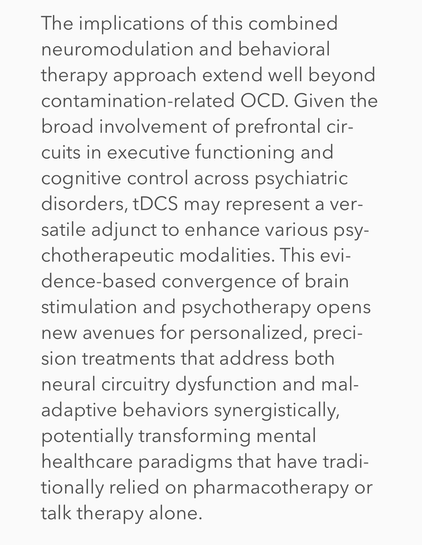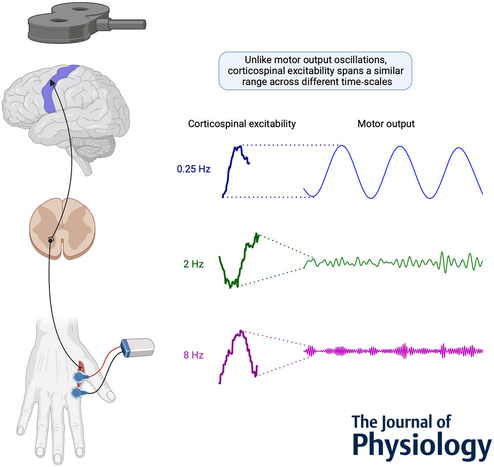Brain Stimulation assisted psychotherapy — OCD Treatment Effectiveness #mentalhealth #cognitivebehavioraltherapy #psychotherapy #brainstimulation #ocd #neuroscience #psychedelicresearch https://apple.news/Aw_vc3Z2RQUaWZgNFVUPdFg https://doi.org/10.1038/s44220-025-00410-w
#brainstimulation
2/4 How does it work? A small device is implanted in the brain, delivering electrical impulses to the GPi. The study found significant improvements in sleep quality for patients, especially those with left sensorimotor GPi stimulation. #BrainStimulation #Neurology
Imagine having a tiny messenger in your brain that helps your dopamine-producing neurons work better, allowing you to move and feel better. This is the promise of a new nanoparticle-based wireless deep brain stimulation system that has shown significant improvements in motor function and reduced symptoms in patients with Parkinson's disease! #Parkinsons #Nanoparticles #BrainStimulation https://curedigest.com/science-news/parkinsons/a-nanoparticle-based-wireless-deep-brain-stimulation-system-that-reverses-parkinson-s-disease
New Study Finds Subthalamic Stimulation Improves Voluntary Decision-Making in Parkinson's Patients - A recent study reveals that subthalamic stimulation can help people with Parkinson's disease make better decisions, improving their quality of life! 🌟 #Parkinsons #DecisionMaking #BrainStimulation #HealthResearch #QualityOfLife https://curedigest.com/science-news/parkinsons/new-study-finds-subthalamic-stimulation-improves-voluntary-decision-making-in-parkinson-s-patients
We can't return we can only look
Behind from where we came
And go round and round and round
In the circle game
#JoniMitchell – The Circle Game
#Consciousness in about #2000 words and a Joni Mitchell song
#Blindsight #BrainStimulation #epilepsy #HardProblem #NeuralCorrelates #neurology #SplitBrain #DavidChalmers
#DanielDennet
#GiulioTononi #PatientHM
#JosephLeDoux #Gazzaniga #NedBlock
#PatriciaChurchland #PaulChurchland
#WilderPenfield #blog #writing
Real-time brain stimulation slashes Parkinson's symptoms by half in trial
https://www.livescience.com/health/neuroscience/real-time-brain-stimulation-slashes-parkinson-s-symptoms-by-half-in-trial #brain #health #treatment #parkinsons #BrainStimulation #NeurodegenerativeDisease #cDBS
Can brain stimulation cure social anxiety? I have my doubts
https://pubpeer.com/publications/5AF9859DC4D5A82F7FBA338CA95805
#brainstimulation #pubpeer #dataintegrity #anxiety
I was a bit dubious about this study in the Guardian https://www.theguardian.com/science/article/2024/jun/16/electrical-brain-stimulation-tdcs-ease-heartbreak-love-trauma-syndrome, and now it's led me down a rabbit hole finding loads of papers that misused G*power and are consequently badly underpowered .
And the original 'brain stimulation eases hearbreak" paper is looking v problematic.
https://pubpeer.com/publications/97F448941AEE8F0212D345EC07626E#8
#statistics #brainstimulation #PubPeer
Dr. Aryn Gittis shared insights about basal ganglia circuits and the new deep brain stimulation protocol that she is developing which leverages knowledge of these circuits and neuron firing patterns to provide longer-lasting effects.
#basalganglia #brain #neuro #neuroscience #research #science #podcast #podcasts #scicomm #sciencecommunication #parkinsons #ParkinsonsDisease #PD #DBS #BrainStimulation
Hey #SOBP2024 community! As a Stanford Postdoc in #interventionalpsychiatry, I've worked on #brainstimulation and #ketamine clinical trials for treatment-resistant #depression. It's my second year here and I couldn't be more thrilled! Look out for my poster presentation (F151) tomorrow. I'm eager to connect with fellow researchers and share our data.
We have a 2-years postdoc position on Transcranial Focused Ultrasound Stimulation. Check it out and apply, working with Lasse is great!
Postdoctoral researcher in Transcranial Focused Ultrasound Stimulation
The ‘Control of Movement’ group @ DRCMR (lassec@drcmr.dk) is seeking candidates for a two-year postdoctoral fellowship within the area of Precision Brain Stimulation. We are looking for an ambitious postdoctoral researcher to conduct research at the intersection of brain stimulation and neuroimaging. Join a young and energetic team, as we expand our efforts within state-of-the-art brain stimulation.
You will head our efforts to steer transcranial focused ultrasound stimulation (TFUS) to deep brain targets otherwise inaccessible to non-invasive brain stimulation. You will be part of a transdisciplinary group working at the forefront of non-invasive brain stimulation. We strive to bring non-invasive brain stimulation research to the highest level of precision and efficacy by combining TFUS with computational targeting and dosing along with concurrent (EEG) and subsequent (fMRI) neuroimaging.
Summary of the project: In this collaborative and translational project, we will use acoustic modelling to determine position and intensity of stimulation, and employ EEG and fMRI to investigate neural effects of stimulating deep cerebellar nuclei. TFUS is a novel and emergent brain stimulation modality, and there is still much to learn. In contrast to other non-invasive brain stimulation modalities, TFUS can penetrate deep into the brain with high precision, which allows us to manipulate deep brain targets directly for the first time. By combining TFUS with neuroimaging we can, for the first time, address questions related to how the cerebellar output influence movement initiation and control in humans.
Your role: You will plan, execute, and analyze results from experiments combining TFUS with EEG and fMRI.
You will design and conduct TFUS experiments using event-related EEG to evaluate immediate effects and fMRI at 3T to evaluate after-effects.
You will write the data up for publication and dissemination.
Essential skills & experience:
• Practical research experience with EEG and/or fMRI
• Proficiency in signal processing and analysis of EEG and/or fMRI
• Coding skills in Python and/or Matlab
• PhD in biomedical/electrical engineering, clinical medicine, neuroscience, or related field
• Prior refereed journal publications
• Strong written and interpersonal communication skills
Advantageous skills & experience:
• Experience in applying transcranial brain stimulation and in conducting human neurophysiological experiments with an understanding of the strengths and limitations of various study designs
• Experience in combining transcranial brain stimulation with brain mapping for dose-response characterization
Working at DRCMR. You will be part of the ‘Control of Movement’ group, headed by Lasse Christiansen at the Danish Research Centre for Magnetic Resonance (www.drcmr.dk) based at Copenhagen University Hospital Hvidovre. You will have the opportunity to collaborate with engineers, neurologists, psychologists, and interact with other groups at DRCMR.
DRCMR is a leading research center for brain stimulation and biomedical MRI in Europe. Approximately 75 researchers from a diverse range of disciplines are currently pursuing basic and clinically applied research. The DRCMR is embedded in the Center for Functional and Diagnostic Imaging and Research, a large diagnostic imaging department including all biomedical imaging modalities at the Copenhagen University Hospital Amager and Hvidovre, Copenhagen, Denmark. DRCMR has a state-of-the-art MR-research infrastructure enabling translational research, which includes a pre-clinical 7T MR scanner, six whole-body MR scanners (one 7T, three 4T and two 1.5T scanners) and a High-Performance Computer cluster dedicated for neuroimaging data. The DRCMR has pre-clinical labs, a neuropsychology laboratory, an EEG laboratory, and five laboratories for precision brain circuit stimulation. It is situated ~25mins cycle ride from central Copenhagen, a city consistently ranked one of the highest in the world for quality of life.
Application deadline: 21st May 2024. Interviews of shortlisted candidates will be held in May / early June.
Starting date: expected to be 1st August 2024, or as soon as possible thereafter.
Salary and terms of Employment. You will be employed for a period of 24 months at the Danish Research Centre for Magnetic Resonance. Salary, pension and terms of employment are in accordance with the agreement between the Danish Regions (Danske Regioner) and the relevant professional organization. The salary depends on background education and seniority. Further supplements can be negotiated. Note that candidates coming from abroad may be eligible for tax reductions. The position is open for candidates of all nationalities. We see diversity as a strength and encourage all candidates regardless of gender, age, ethnicity, disabilities or religion to apply.
Application details: Applications should include a cover letter, CV, list of publications & research outputs, together with the names of three references.
Applications must be submitted on-line through the RegionH job portal.
For further information regarding the position please contact Research Fellow Lasse Christiansen: lassec@drcmr.dk , Phone# +4553853305
New preprint! We observed a nonlinear relationship between pupil dilation and the intensity of transcutaneous auricular #vagus nerve stimulation (#taVNS) in adult humans. We discuss the potential role of stimulation parameterization in using #pupillometry as biomarker of taVNS’s neuromodulatory effects.
#tVNS #neuromodulation #brainstimulation #gamms
Advances in neurosurgical treatments like focused ultrasound and deep brain stimulation are moving the field towards more personalized care for Parkinson's disease. To learn more, tune in to my conversation with Dr. Doris Wang in this new podcast episode in partnership with The Michael J. Fox Foundation for Parkinson's Research!
#Parkinsons #ParkinsonsDisease #PD #DBS #BrainStimulation #Neurosurgery #neuroscience #research #science #sciencecommunication #Scicomm #podcast #podcasts #STEM
#VR and electric #brainstimulation show promise for treating #PTSD
Acacia Clinics is recruiting research participants with anxiety who can come to their site in Sunnyvale, CA.
Acacia is renowned for their works in noninvasive brain stimulation for mental health.
This study is designed to study whether low-intensity ultrasound can temporarily alter self-reported anxiety and brain activity related to emotional processing.
https://www.acaciaclinics.com/tus-anxiety-trial
Hi everyone! I'm very happy to post our new paper we just got published in the Journal of Physiology:
"Scale-invariant Changes in Corticospinal Excitability Reflect Multiplexed Oscillations in the Motor Output"
(Open access here: tinyurl.com/yka2w7hb )
Authors are @marco_emanuele , me, Giacomo Koch, Luciano Fadiga and Alice Tomassini
It took quite some time and effort to get it nice and polished, and now I'm so proud of it!
Marco and Alice did an amazing job!
#Neuroscience #BrainStimulation #sensorimotor #neurophysiology
@IIT_UniFe
19th Annual Mood Disorders Education Day
Saturday, October 14, 2023
9:00 AM – 1:00 PM (PT)
Translating Emerging Treatments for Mood Disorders Into Practice
Please join the Stanford University Mood Disorders Center for exciting presentations on #brainstimulation, #psychedelics, #ketamine, and personalized treatment of mood disorders. Pre-registration is free, but is required to attend the event. Space is limited, so register early!
Brain stimulation could boost maths ability
Scientists used high-frequency random noise stimulation, which sends a mild electrical current to the brain through two electrodes.
#TechForGood
#BrainStimulation
#CognitiveEnhancement
#BrainTraining

